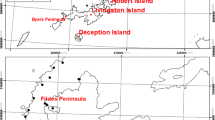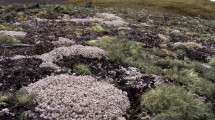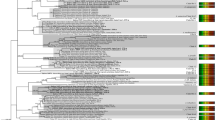Abstract
Mycobiont and photobiont genetic diversity was investigated in four taxa of the Tephromela atra complex, which differ in ecology and substratum preference (from siliceous rocks, limestone to bark), and are differently interpreted by taxonomists. Phylogenetic analyses were performed using mycobiont nuclear ITS, beta tubulin and homologous polyketide synthase gene (PKS) sequences obtained from freshly collected material sampled from the Mediterranean region to the Southern Alps. The silicicolous samples from the Alps form a basal lineage of the entire complex, and despite the morphological similarity, they do not form a monophyletic group with the Mediterranean samples. No resolution was found among the calcicolous and the silicicolous taxa from Mediterranean habitats, which are traditionally segregated at variety or species level. The epiphytic taxon, although nested with the other ecotypes, splits in two well-supported lineages. Among the four taxa, Tephromela grumosa is the only morphologically, chemically and genetically distinct taxon. However, it is also nested in the large T. atra complex. Phylogenetic analysis of photobionts ITS sequences revealed that thalli from the Mediterranean region are associated with two distinct lineages of Trebouxia, but the lineages are not correlated with substrate or mycobiont phenotype. The thalli from the Alps are exclusively associated with T. simplex, suggesting a protracted isolation from the other lineages.






Similar content being viewed by others
References
Beck A, Kasalicky T, Rambold G (2002) Myco-photobiontal selection in a Mediterranean cryptogam community with Fulgensia fulgida. New Phytol 153:317–326
Bingle LEH, Simpson TJ, Lazarus CM (1999) Ketosynthase domain probes identify two subclasses of fungal polyketide synthese genes. Fungal Genet Biol 26:209–223
Blaha J, Baloch E, Grube M (2006) High photobiont diversity associated with the euryoecious lichen-forming ascomycetes Lecanora rupicola (Lecanoraceae, Ascomycota). Biol J Linn Soc 88:283–293
Brodo IM, Owe-Larsson B, Lumbsch HT (1994) The sorediate, saxicoulos species of the Lecanora subfusca group in Europe. Nord J Bot 14:451–461
Choisy PM (1929) Genres nouveaux pour la lichénologie dans le groupe des Lécanoracée. Bull Soc Bot Fr 76:521–522
Clauzade G, Roux Cl (1985) Likenoj de Okcidenta Europo. Illustrita Determinlibro. Bull Soc Bot Cent Ouest. Numero Spec 7:1–893
Clement M, Posada D, Crandal KA (2000) TCS: a computer program to estimate gene genealogies. Mol Ecol 9:1657–1659
Clerc P (2004) Les champignons lichénisés de Suisse. Catalogue bibliographique complete par des données sur la distribution et l’écologie des espèces. Cryptogam Helvet - Saussurea 34:136–137
Cubero OF, Crespo A, Fatehi J, Bridge PD (1999) DNA extraction and PCR amplification method suitable for fresh, herbarium stored and lichenized fungi. Plant Syst Evol 217:243–249
Du Rietz GE (1930) The fundamental units of biological taxonomy. Svensk. Bot. Tidskr. 24:333–428
Egea JM, Alonso FL (1996) Patrones de distribución en la flora liquénica xerófila del sureste de España [Distribution patterns in the xerophilous lichen flora of the southeastern Spain]. Acta Bot Malacit 21:35–44
Elix JA, Kalb K (2006) Two new species of Tephromela (Lecanoraceae, lichenized Ascomycota) from Australia. Aust Lichenol 58:27–31
Fröberg L (1989) The Calcicolous Lichens on the Great Alvar of Öland, Sweden. Institutionen för Systematisk Botanik, Lund
Galun M, Mukhtar A (1996) Checklist of the lichens of Israel. Bocconea 6:149–171
Gardes M, Bruns TD (1993) ITS primers with enhanced specificity for basidiomycetes. Application for the identification of mycorrhizae and rust. Mol Ecol 2:113–118
Glass NL, Donaldson GC (1995) Development of primer sets designed for use with the PCR to amplify conserved genes from the filamentous ascomycetes. Appl Environ Microbiol 61:1323–1330
Grube M, Kroken S (2000) Molecular approaches and the concept of species and species complexes in lichenized fungi. Mycol Res 104:1284–1294
Grube M, Lindblom L, Mayrhofer H (2001) Contribution to the lichen flora of Crete: a compilation of references and some new records. Stud Geobot 20:41–59
Hafellner J (1984) Studien in Richtung einer naturlicheren Gliederung der Sammelfamilien Lecanoraceae und Lecideaceae. In: Hertel H, Oberwinkler F (eds) Beitrage zur Lichenologie. Festscrift J. Poelt. Beiheft zur Nova Hedwigia 79. Cramer J, Vaduz, pp 241–371
Hafellner J (1992) A new checklist of lichenized and lichenicolous fungi of the Madeira Archipelago. Institut für Botanik der Karl-Franzens-Universität, Graz, pp 29
Hafellner J, Türk R (2001) Die lichenisierten Pilze Österreichs - eine Checkliste der bisher nachgewiesenen Arten mit verbreitungsangaben. Stapfia 76:1–167
Hall TA (1999) BioEdit: a user friendly biological sequence alignment editor and analysis program for Windows 95/98/NT. Nucleic Acids Symp Ser 41:95–98
Hauck M, Helms G, Friedel T (2007) Photobiont selectivity in the epiphytic lichens Hypogymnia physodes and Lecanora conizaeoides. Lichenologist 39:195–204
Helms G, Friedl T, Rambold G, Mayrhofer H (2001) Identification of photobionts from the lichen family Physciaceae using algal-specific ITS rDNA sequencing. Lichenologist 33:73–86
Hesbacher S, Fröberg L, Baur A, Baur B, Proksch P (1996) Chemical variation within and between individuals of the lichenized ascomycete Tephromela atra. Biochem Syst Ecol 24:603–609
Hudson W (1762) Flora Anglica, 1st edn. London
Huelsenbeck JP, Ronquist F (2003) MRBAYES 3: Bayesian phylogenetic inference under mixed models. Bioinformatics 19:1572–1574
Huneck S, Porzel A, Lumbsch HT (1997) Zur Chemie von Hypotrachyna rachista und Tephromela atra var. cypria. Herzogia 12:39–43
Jüriado I (1997) Epilithic species of the lichen genera Lecanora, Protoparmelia and Tephromela in Estonia. Folia Cryptogam Est 31:26–29
Kalb K, Hafellner J (1992) Bemerkenswerte Flechten und lichenicole Pilze von der Insel Madeira. Herzogia 9:45–102
Kroken S, Taylor JW (2000) Phylogenetic species, reproductive mode, and specificity of the green alga Trebouxia forming lichens with the fungal genus Letharia. Bryologist 103:645–660
Limona X, Hladun NL (2001) Checklist of the lichens and lichenicolous fungi of the Iberian Peninsula and Balearic Islands. Bocconea 14:1–581
Litterski B, Mayrhofer H (1998) Catalogue of lichenized and lichenicolous fungi of Cyprus. Stud Geobot 16:57–70
Maheu J, Gillet A (1992) Contribution a l’ètude des Iles Balèares. Bull Soc Bot Fr 68:426–436
Mayr E (1963) Animal species and evolution. Belknap Press, Cambridge, Mass.
McNeill J, Barrie FR, Burdet HM, Demoulin V, Hawksworth DL, Marhold K, Nicolson DH, Prado J, Silva PC, Skog JE, Wiersema JH, Turland NJ (eds) (2006) International Code of Botanical Nomenclature (Vienna Code). Regnum Veg 146:1–568
Miadlikowska J, Kauff F, Hofstetter V, Fraker E, Grube M, Hafellner J, Reeb V, Hodkinson BP, Kukwa M, Lücking R, Hestmark G, Garcia Otalora M, Rauhut A, Büdel B, Scheidegger C, Timdal E, Stenroos S, Brodo I, Perlmutter G, Ertz D, Diederich P, Lendemer JC, May P, Schoch CL, Arnold AE, Gueidan C, Tripp E, Yahr R, Robertson C, Lutzoni F (2006) New insights into classification and evolution of the Lecanoromycetes (Pezizomycotina, Ascomycota) from phylogenetic analyses of three ribosomal RNA and two protein-coding genes. Mycologia 98:1088–1103
Motyka J (1996) Porosty (Lichenes). Tom II. Rodzina Lecanoraceae. Lubelskie Towarzystwo Naukowe, Lublin
Muggia l, Grube M, Tretiach M (2008) A combined molecular and morphological approach to species delimitation in black-fruited, endolithic Caloplaca: high genetic and low morphological diversity. Mycol Res 112:36–49
Nash TH, Kalb K, Rambold G (2004) Tephromela. In: Ryan BD, Diederich P, Gries C, Bungartz F (eds) Lichen flora of the greater Sonoran Desert region. Lichens Unlimited, Arizona State University, Tempe, Arizona, pp 530–531
Nimis PL (1993) The Lichens of Italy. Museo Regionale di Scienze Naturali, Torino
Nimis PL, Martellos S (2003) A Second Checklist of the Lichens of Italy with a Thesaurus of Synonyms. Monografie del Museo Regionale di Scienze Naturali, vol. 4, Museo Regionale di Scienze Naturali Saint-Pierre, Valle d’Aosta, Aosta
Nimis PL, Tretiach M (1999) Itinera Adriatica – Lichens from the eastern part of the Italian Peninsula. Stud Geobot 18:51–106
Page RDM (1996) TREEVIEW: An application to display phylogenetic trees on personal computers. Comput Appl Biosci 12:357–358
Poelt J, Grube M (1993) Beitrage zur Kenntnis der Flechtenflora des Himalaya VI- die Gattung Tephromela (mit Bemerkungen zum Genus Heppsora). Nova Hedwig 57:1–17
Posada D, Crandall KA (1998) Modeltest - testing the model of DNA substitution. Bioinformatics 14:817–818
Printzen C, Ekman S, Tønsberg T (2003) Phylogeography of Cavernularia hultenii: evidence of slow genetic drift in a widely disjunct lichen. Mol Ecol 12:1473–1486
Purvis OW, Coppins BJ, Hawksworth DL, James PW, Moore DM (eds) (1992) The Lichen Flora of Great Britain and Ireland. Natural History Museum Publications & British Lichen Society, London
Rambold G (1989) A monograph of the saxicolous lecideoid lichens of Australia (excl. Tasmania). Bibl Lichenol 34:1–345
Rambold G (1993) Further species of the genus Tephromela (Lecanorales). Sendtnera 1:281–288
Rodriguez F, Oliver JL, Marin A, Medina JR (1990) The general stochastic model of nucleotide substitution. J Theor Biol 142:485–501
Ronquist F, Huelsenbeck JP, Van der Mark P (2005) MrBayes 3.1 Manual. http://mrbayes.csit.fsu.edu/mb3.1_manual.pdf.
Salvadori O, Tretiach M (2002) Thallus-substratum relationships of silicicolous lichens occurring on carbonatic rocks of the Mediterranean region. Bibl Lichenol 82:57–64
Santesson R (ed) (1993) The lichens and lichenicolous fungi of Sweden and Norway. Lund, Sweden
Seaward M (1996) The Oxford University lichen herbaria. Oxford Plant Syst 4:14–15
Suppan U, Prügger J, Mayrhofer H (2000) Catalogue of the lichenized and lichenicolous fungi of Slovenia. In: Cramer J (ed) Bibl Lichenol 76. Berlin, Stuttgart
Tretiach M (2002) Niesslia robusta, a new lichenicolous fungus on Tephromela grumosa from Tuscany, Italy. Nova Hedwig 75:357–365
Türk R, Hafellner J, Taurer-Zeiner C (2004) Die Flechten Kärntens. Eine Bestandsaufnahme nach mehr als einem Jahrhundert lichenologischer Forschung. In: Natur Kärnten. Sonderreihe des Naturwissenschaftlichen Vereins für Kärnten, Band 2. Carinthian Bogendruck Gmbh., Klagenfurt, pp 304–305
Wei J-c (1991) An Enumeration of Lichens in China. International Academic Publishers, Beijing, China
White TJ, Bruns TD, Lee S, Taylor J (1990) Amplification and direct sequencing of fungal ribosomal DNA genes for phylogenies. In: Innis MA, Gelfand DH, Snisky JJ, White TJ (eds) PCR protocols, a guide to methods and applications. Academic Press, San Diego, pp 315–322
Wirth V (1995) Die Flechten Baden-Württembergs, Teil 1 & 2. Eugen Ulmer, Stuttgart, Germany
Wirth V (2007) Tephromela nashii Kalb in Afrika. In: Frisch A, Lange U, Steiger B (eds) Lichenologische Nebenstunde. Contribution to lichen taxonomy and ecology in honour of Klaus Kalb. Bibl Lichenol 96:311–313
Wirtz N, Printzen C, Lumbsch HT (2008) The delimitation of Antarctic and bipolar species of neuropogonoid Usnea (Ascomycota, Lecanorales): a cohesion approach of species recognition for the Usnea perpusilla complex. Mycol Res 112:472–484
Acknowledgments
This investigation started as a case study during an introductory course on molecular techniques in Lichenology, organised by the Italian Lichen Society and led by Martin Grube in Trieste in September 2004. We acknowledge all the participants, particularly Silvana Munzi (Siena), and Bruna Marini (Trieste), for technical help. Giovanna Potenza (Potenza) is thanked for providing selected specimens, Josef Hafellner (Graz), Andrea Moro and Massimo Piccotto (Trieste) for companionship during field work. Partial financial support was given by the University of Trieste (responsible M. Tretiach), and by the Austrian Science Foundation (FWF, P18632).
Author information
Authors and Affiliations
Corresponding author
Rights and permissions
About this article
Cite this article
Muggia, L., Grube, M. & Tretiach, M. Genetic diversity and photobiont associations in selected taxa of the Tephromela atra group (Lecanorales, lichenised Ascomycota). Mycol Progress 7, 147–160 (2008). https://doi.org/10.1007/s11557-008-0560-6
Received:
Revised:
Accepted:
Published:
Issue Date:
DOI: https://doi.org/10.1007/s11557-008-0560-6




